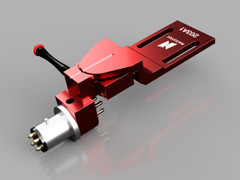The 17th Annual Positive Feedback Writers' Choice Awards for 2020

Analogue Fellowship - 06-03-2020
Click photo!

Positive Feedback - 03-02-2020
Click photo!
HiFi Pig - Dec 19, 2018

Click here.
What's Best Forum - Sep 16, 2017
Click photo.
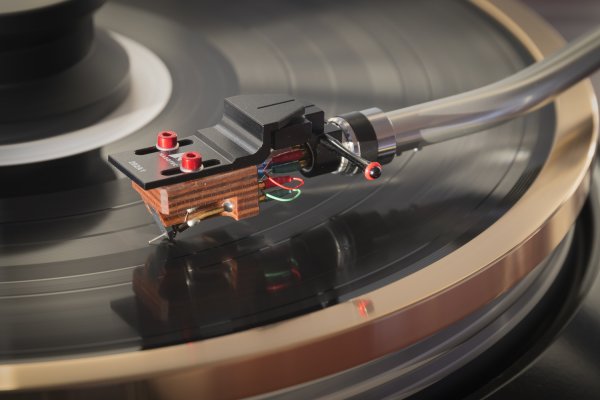
[Review from What's Best Forum]
We were allowed to post this article by Mr. Paul Stratton in UK.
Intrigue got the better of me (yet again) after discovering this by chance, so an order went in and on return from a trip overseas,
it was waiting here for me. I didn't intend installing it just yet as my TT is not fully finished but the other night thought ok, let's just
give it a go and spent a couple of hours swapping the Art 9 over and getting the set up spot on with my laser engraved protractor
specific to my SAEC WE506/30. Prior I was using SAEC ULS-3x, sintered aluminium oxide which is extremely hard material and
very very stiff. This is the top SAEC headshell. Though I have not used any other shell's on my arm, I do have access to several
through friends but was always contenet with the ULS-3x, so just stayed with it.
Anyway, the improvement that the Nasotec is claiming is to 'reduce', not eliminate error, from a pivoting arm. There is plenty of technical
info on their website about why and what they are aiming at with this. Does it make any difference? Yes, it does. After the first few
notes on Tracy Chapmans wonderful debut LP, it was obvious that the claims are backed up with ability. Notes seem to just flow
unconstrained, at ease, with what I had considered more background notes, ambience etc coming more to the fore, bass in particular
has very good texture and clean decay which really fleshes out the sound. A dozen or more Lp's simply confirm this, and last night,
my Antal Dorati-Decca DMM-Stravinsky Rite of Spring sounded better than I have heard before, anywhere, truly captivating from
beginning to end.
I imagine that the Nasotec gives a taste of what a tangential gives, and is a good option for many vintage arms out there & still in use.
Floating with crisp imaging free from speakers is what this brings, possibly not to the level of a good parallel(?) but very very enjoyable,
so much so that the cost is not an issue for what it does.
Conan Lee, HiFi Audio Reviewer - Aug 10, 2016
 Conan Lee, HiFi Audio Reviewer, Aug 10, 2016
Conan Lee, HiFi Audio Reviewer, Aug 10, 2016
By putting LP on the platter and using the tonearm, a turntable is made in a way that the groove of the LP is read on the
cartridge. It is easy to say everything, but we have to overcome various struggles in order to produce better sound quality
through the turntable. Honestly, after setting tonearm and cartridge, you just have to listen to the music, but audiophiles do
not do so.


We struggle because of the innate problem that a turntable has with tonearm and cartridge setting. Among all these, tracking
error angle creates various troubles and as a solution different types of tonearm were created. Primarily in a rotating lacquer
record disk, a cutting machine moves from the outside to the inside straightly and creating the groove, but when playing the
groove, the normal tonearms turn on a pivot. Because of this, even if you set cartridge offset and overhang accurately, the
cartridge cannot track the groove straightly.

[Clearaudio linear tonearm]
Theoretically speaking, as you see in the diagram above, the cartridge can be set in a straight at only two points. Therefore,
when you look at the cartridge alignment protractors, two points are found to set the cartridge alignment. To solve this problem,
some of the highend tonearm makers created linear tracking tonearm. Clearaudio, Kuzma are examples of the created linear
tracking tonearms. Preferring long arms over short arms out of normal tonearms is because long arms can easily reduce
tracking error angle.
However, linear tracking tonearm is not proficient in every aspect. Therefore, it also has a lot of roblems. Theoretically close
is the tonearm of the Thales. It is constructed in the structure of the dual shaft, so tracking angle can be changed through the
movement of the tonearm. By looking at the Thales Simplicity, the angular difference between the tonearm shaft and the
headshell due to the swing angle of the tonearm, you will get to understand it much better.
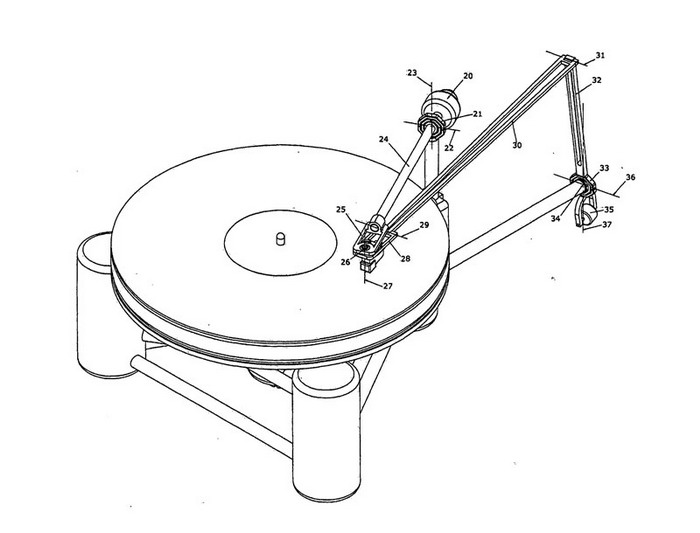
[Thales tonearm]
Swing Headshell is created to lessen the tracking error angle and to improve tracking ability. It was originally created in Nasotec
and it shows quite excellent effect. Basically, Swing Headshell is created in a way that the swing head can move left and right
softly. Furthermore, the tracking error angle is naturally revised by the inertia of the rotating LP that moves the groove. It is
hard to prove everything theoretically, but if you get a chance to use it, you will definitely hear the sound clearly that even
reaches to the very inside of the LP groove. The balance of the swing and the tension of the spring can controlled by tightening
or loosening the spring at the back of the headshell.
At the end of the spring, there is a bearing ball. This bearing ball has a crucial role. It helps absorb the vibration made when
cartridge reads the groove. Additionally, swing headshell has the function of lessening the tracking error angle and also
minimizes the arm resonance.

I have summarized the results that came out by using it for a month. I tested SME 3010R tonearm and DL103R mpingo
version on the VPI turntable.
*Sound Quality
1. It does not affect the overall tonal balance.
2. Accuracy of tracking error angle cannot be provided, but the difference of sound quality is apparent.
- Smooth connection in the entire frequency range.
- Abundant harmony and natural reverberation.
- High pitch becomes detailed and silky.
- Whole tone of saxophone and trumpet becomes abundant, so the impression of the space seems to be bigger than other
headshells.
- Compared to a firm bass, it is a little bit softer and becomes more abundant.
*Usability/ Design
1. Managing the rear spring tension is a little uncomfortable because of the fingerlift.
2. There is no standard tension management, so it should be repeated for several times to find the best tension.
3. The effect of tracking ability differs by the way lead wire is formed.
4. Satisfaction of design seems to be good.
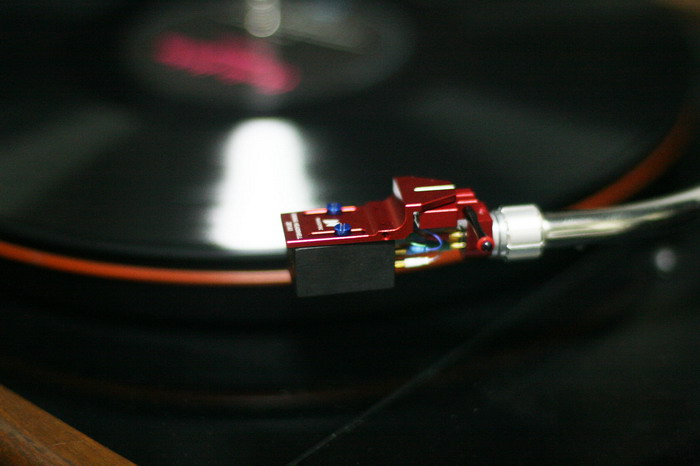
*Conclusion
- Besides the effect of lessening the tracking error angle, the decreasing effect of tonearm vibration cannot be ignored.
- Setup should be more detailed for abundant sound quality than it originally is.
- When headshell changed, tracking force and anti-skating must be re-controlled.
- If lead wires get tangled, it results into the disturbance of the movement of headshell. Therefore, simple setup should be
found to not make lead wires tangled.
- If used together with HiFistay clamp, synergy becomes bigger.

I am still testing, but I am pretty sure that once I get some positive results, I do not want to get back to the original SME
headshell. I have preserved my original headshell and have tried various music with Swing headshell and vinyl pressings.
The merit of universal type tonearm is that the cartridge can be equipped with different types of headshells and can listen
to the music whenever wanted. Of course, I have to change settings each time.
Since I have a good headshell which does not happen everyday, I also want to have one more arm if possible, one as stereo
and one as mono.

[Korean] Click Here
Review by YY Choi, 11/25/2016
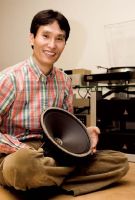
page 1 / page 2 / page 3
[Review from What's Best Forum]: http://www.whatsbestforum.com/showthread.php?23903-Nasotec-Swing-Headshell
We were allowed to post this article by Mr. Paul Stratton in UK.
Intrigue got the better of me (yet again) after discovering this by chance, so an order went in and on return from a trip overseas,
it was waiting here for me. I didn't intend installing it just yet as my TT is not fully finished but the other night thought ok, let's just
give it a go and spent a couple of hours swapping the Art 9 over and getting the set up spot on with my laser engraved protractor
specific to my SAEC WE506/30. Prior I was using SAEC ULS-3x, sintered aluminium oxide which is extremely hard material and
very very stiff. This is the top SAEC headshell. Though I have not used any other shell's on my arm, I do have access to several
through friends but was always contenet with the ULS-3x, so just stayed with it.
Anyway, the improvement that the Nasotec is claiming is to 'reduce', not eliminate error, from a pivoting arm. There is plenty of technical
info on their website about why and what they are aiming at with this. Does it make any difference? Yes, it does. After the first few
notes on Tracy Chapmans wonderful debut LP, it was obvious that the claims are backed up with ability. Notes seem to just flow
unconstrained, at ease, with what I had considered more background notes, ambience etc coming more to the fore, bass in particular
has very good texture and clean decay which really fleshes out the sound. A dozen or more Lp's simply confirm this, and last night,
my Antal Dorati-Decca DMM-Stravinsky Rite of Spring sounded better than I have heard before, anywhere, truly captivating from
beginning to end.
I imagine that the Nasotec gives a taste of what a tangential gives, and is a good option for many vintage arms out there & still in use.
Floating with crisp imaging free from speakers is what this brings, possibly not to the level of a good parallel(?) but very very enjoyable,
so much so that the cost is not an issue for what it does.
[HiFi Choice]: https://cdn2.bigcommerce.com/server2100/hbjmdwl2/product_images/uploaded_images/hfc-429-nasotec-re-print-half-page-m.jpg?t=1507766854

[ReMusic.it] 01/12/2017
Nasotec Swing Headshell 202A1 and accessories for turntable calibration
[Facebook]
-Hanze Hifi
https://www.facebook.com/permalink.php?story_fbid=1718874614829218&id=211704305546264
https://www.facebook.com/permalink.php?story_fbid=2070899986466667&id=100006400575429&pnref=story
 Loading... Please wait...
Loading... Please wait...
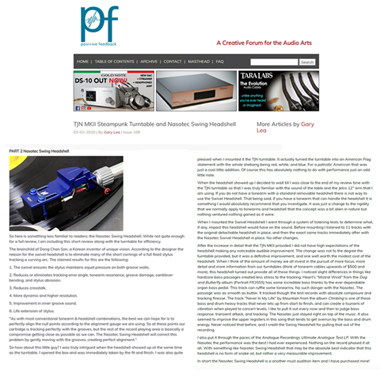


Conan Lee, HiFi Audio Reviewer, Aug 10, 2016

























![[Catalog] - Swing Headshell](https://cdn2.bigcommerce.com/server2100/hbjmdwl2/products/380/images/924/headshell_catg__19402.1466739367.240.180.jpg?c=2)
![[Manual] - Swing headshell](https://cdn2.bigcommerce.com/server2100/hbjmdwl2/products/462/images/1631/manualen_web-1__56633.1583568855.240.180.jpg?c=2)
![[Review by AAA Switzerland] - Swing headshell [German]](https://cdn2.bigcommerce.com/server2100/hbjmdwl2/products/645/images/1921/Sommer_2023_low_res_nasotec-5__28229.1711720009.240.180.jpg?c=2)
